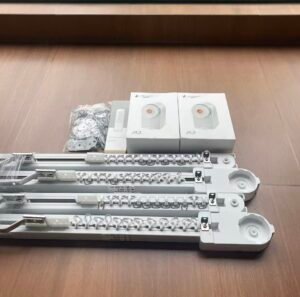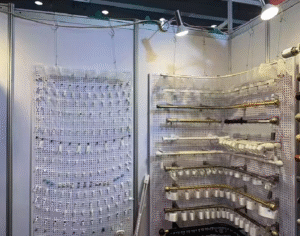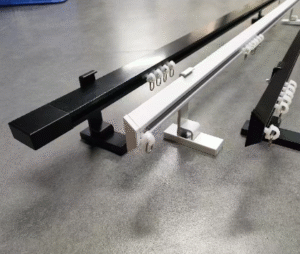That one grating sound can ruin a perfect experience. In a luxury hotel or a focused office, small noises feel amplified, making the entire space feel cheap and unprofessional.
Acoustics are vital for creating environments that promote rest and productivity. In hotels, good acoustics mean undisturbed sleep for guests. In offices, they ensure employee focus. Silent curtain tracks are a key detail in achieving this high-quality, professional atmosphere.
I've seen a major shift in what clients prioritize. Years ago, the focus was just on strength and durability. Now, for commercial projects, my long-term partner Matt, a Purchasing Manager for a top US firm, specifies the decibel level for track operation. He knows that in a premium space, the absence of noise is the ultimate luxury. It’s not just about what guests or employees see; it's about what they don't hear. Let's dig into why this small detail has such a big impact on the perceived quality of a space.
How Do Noisy Curtain Tracks Disrupt Guest and Employee Comfort And How do curtains reduce noise?
Imagine the jarring squeal of a curtain track in a silent room. It shatters the peace, whether a guest is sleeping or an employee is deep in thought.
Noisy tracks create high-frequency, unexpected sounds that disrupt sleep and shatter concentration. Curtains themselves reduce noise by absorbing sound waves with their fabric. Heavy, dense blackout curtains are especially effective at dampening external sounds, creating a quieter internal environment.
The human brain is wired to react to sudden, sharp noises. It’s a primal startle response. In a hotel room, the sound of grinding plastic or scraping metal as a guest draws the curtain can be enough to wake them up.
In an office, it pulls everyone out of their focused state. This is a direct hit to the core function of the space—rest or productivity. The track's job is to operate in silence.
The curtain's role is different; it's about managing external noise.
The Role of Fabric and Fit
A curtain track enables a room's acoustic performance. To effectively dampen sound from the outside, you need to hang heavy, thick curtains, often with a blackout or interlining. A high-quality, robust track is required to support this weight without sagging. The magic happens when these heavy curtains are installed on a ceiling-to-floor track. This creates a complete fabric barrier that absorbs sound vibrations that would otherwise pass through the glass window and reflect off hard surfaces in the room. The curtain acts like a large acoustic panel, deadening sound and reducing echo to create a more serene atmosphere.
What Makes Silent Curtain Track Systems Different in Design?
From a distance, all curtain tracks look the same. But cheap ones will inevitably grind, stick, and squeak, while premium ones operate in total silence for years.
Silent tracks use superior materials and precision engineering. Key differences include specially coated channels, advanced glider designs like silicone-injected wheels, and sound-dampening components. These elements work together to eliminate friction and prevent any metal-on-metal contact for smooth, silent movement.
As a manufacturer, I live in the details of the design. The difference between a standard track and a silent one comes down to the quality of every single component. It's a complete system designed for one purpose: frictionless movement. We don’t just use better parts; we design parts that work together in harmony. The gliders are shaped to fit the channel profile perfectly, minimizing wobble. The channel itself is extruded to incredibly tight tolerances, ensuring its surface is perfectly uniform. It's a level of precision that you can't see, but you can definitely hear—or rather, you can't.
Here is a comparison of what to look for:
| Component | Standard Track System | Premium Silent Track System |
|---|---|---|
| Track Channel | Basic aluminum or plastic | High-grade aluminum with a smooth powder or nano-coated interior |
| Gliders | Simple molded plastic hooks | Engineered POM plastic with silicone-injected wheels or nano surfaces |
| End Caps | Hard plastic | Soft plastic or rubberized components to absorb shock |
| Movement | Friction-based slide | Near-frictionless roll or glide |
Why are acoustics important in buildings such as office space and hotel?
Ever tried to concentrate with constant background noise? Ignoring acoustics in a building's design can lead to environments where people feel stressed, tired, and unproductive.
Good acoustics are critical for the function of a commercial space. In hotels, they ensure restful sleep, leading to positive guest reviews. In offices, they reduce distractions and improve focus and employee well-being, which directly impacts productivity and job satisfaction.
In any commercial space, controlling sound is about managing the user experience. A building is not just a structure; it's an environment that should support the activities within it. In my discussions with architects and project managers like Matt, acoustic performance is now a non-negotiable part of the design brief, right alongside lighting and thermal comfort.
For a hotel, the primary product is a good night's sleep. Noise is the number one enemy of that product. Guests are paying for a quiet refuge, and a failure to provide that leads directly to complaints and lost repeat business. In an office, the goal is productivity. Studies have shown that constant, low-level noise and unexpected sounds increase stress levels and reduce the ability to concentrate. A well-designed acoustic environment allows employees to perform deep work, collaborate without shouting, and feel more comfortable throughout the day. Investing in acoustics is investing in the core business objective of the space.
How to Choose the Right Silent Curtain Track for Long-Term Use?
Choosing the wrong track can be a costly mistake. A system that fails after a few years requires expensive replacement and causes massive disruption to your business operations.
For long-term use, choose a track made from high-grade, thick-walled extruded aluminum. Insist on seeing samples to test the gliders for a smooth, frictionless feel. Finally, partner with a manufacturer who provides strong warranties and can prove the durability of their components.
Durability is about making the right choice from the start. I always tell buyers to get their hands on a physical sample. You can feel quality. The track should feel substantial and rigid, not flimsy. The wall thickness of the aluminum profile is a key indicator of its strength and resistance to bending over time under the weight of heavy curtains.
What to Look For in a Sample:
- Glider Quality: Slide the glider back and forth in the track. Does it roll smoothly or does it scrape? Are the wheels secure? Quality gliders are the most important moving part, and they should feel effortless.
- Finish Inspection: Look closely at the coating inside the channel. It should be perfectly smooth and uniform. Any bumps or imperfections will cause noise and friction.
- Manufacturer’s Reputation1: Ask about their testing process2. We put our tracks through thousands of open-close cycles to simulate years of heavy use. A good manufacturer will be proud to share this data. A strong warranty isn't just a piece of paper; it’s a manufacturer's vote of confidence in their own product's longevity.
Conclusion
Acoustics are not a luxury; they are essential for performance. Silent curtain tracks are a small but critical investment in creating a peaceful, professional environment that enhances guest satisfaction and employee productivity.








